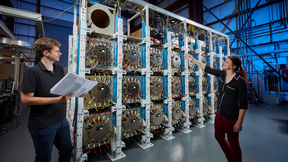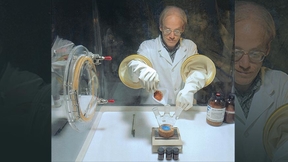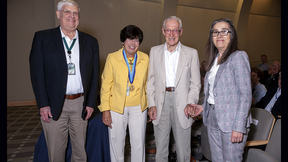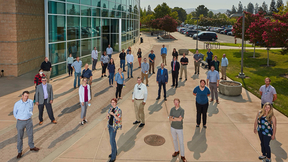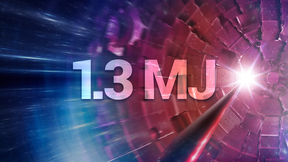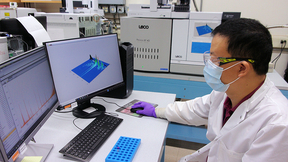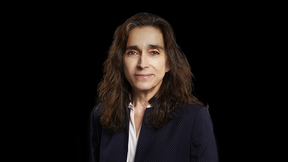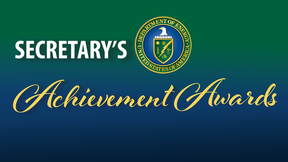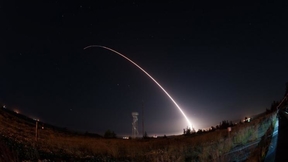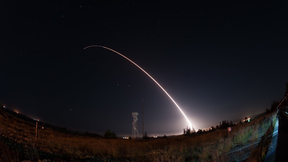Back
Lawrence Livermore National Laboratory Director Kim Budil today announced that the 2023 John S. Foster, Jr. Medal is awarded to retired U.S. Navy Admiral Richard W. Mies. The eighth recipient of the prestigious Foster Award, Mies has served as a member of the LLNL Board of Governors since 2004 and is recognized for his exceptional and inspirational career dedicated to…
Members of Lawrence Livermore National Laboratory’s (LLNL’s) Advanced Sources and Detectors (ASD) Scorpius accelerator team recently marked a major milestone in the project — the delivery of 24 line-replaceable units (LRUs), known as pulsers, forming a complete unit cluster. The LRUs will power the Scorpius electron beam accelerator, which will capture multiple X-ray…
A score of top-ranked university students from around the nation received a one-day “crash course” in some of the critical nuclear science and nonproliferation missions of the Department of Energy (DOE) and National Nuclear Security Administration (NNSA) at an event held earlier this month at Lawrence Livermore National Laboratory (LLNL). Twenty students participated in…
Scientific discovery during the Stockpile Stewardship Program maintains confidence in the nuclear deterrent without testing, brings other benefits The last nuclear test, code-named Divider, took place 30 years ago, on September 23, 1992. That year, President Bush declared a temporary moratorium on nuclear testing, which became permanent during the Clinton administration…
The last nuclear test, code-named Divider, took place 30 years ago, on Sept. 23, 1992. That year, President Bush declared a temporary moratorium on nuclear testing, which became permanent in 1995, during the Clinton administration. This ending of the era of nuclear testing coincided with a Presidential announcement of the beginning of stockpile stewardship. As the decision…
Department of Energy (DOE) Under Secretary for Nuclear Security Jill Hruby joined fellow luminaries in the national nuclear security community at Lawrence Livermore National Laboratory (LLNL) on Sept. 8 to honor Miriam “Mim” John, recipient of the 2022 John S. Foster, Jr. Medal. John, vice president emerita of Sandia National Laboratories, became the first woman awarded…
When Daniel Martin put the finishing touches on an autonomous vehicle robot, complete with an ultrasonic sensor to detect and evade obstacles, he knew he wanted to become an engineer. A high school student at the time, he was fascinated by the design and functionality of robots. Fast forward several years, and Martin is now a second-year electrical engineering Ph.D…
The Post-Detonation Rapid Response Research Venture — also known as R-cubed or R3 — is combining basic research and development of emergent technologies, predictive capabilities and systems assessment to revolutionize the speed and flexibility of technical nuclear forensic (TNF) response to nuclear events. The venture is a multi-laboratory collaboration led by Lawrence…
On Aug. 8, 2021, an experiment at Lawrence Livermore National Laboratory’s (LLNL’s) National Ignition Facility (NIF) made a significant step toward ignition, achieving a yield of more than 1.3 megajoules (MJ). This advancement puts researchers at the threshold of fusion ignition, an important goal of the NIF, and opens access to a new experimental regime. The experiment…
Lawrence Livermore National Laboratory (LLNL) hosted an in-person orientation meeting recently for members of the National Nuclear Security Administration’s (NNSA) Test Site Verification Team (TSVT). TSVT is sponsored by NNSA’s Office of Nuclear Verification (ONV) Nuclear Compliance Verification (NCV) Program. The TSVT is led by Kim Knight from LLNL and Emily Schultz…
This fall, a score of scientists from Lawrence Livermore National Laboratory's (LLNL) Forensic Science Center (FSC) will start two weeks of long days to undertake the Organisation for the Prohibition of Chemical Weapons (OPCW) environmental proficiency test. Livermore scientists have been taking the proficiency tests each October since 2001, with LLNL serving as one of two…
The Advanced Data Analytics for Proliferation Detection (ADAPD) program held a two-day virtual technical exchange meeting recently. The goal of the meeting was to highlight the science-based and data-driven analysis work conducted by ADAPD to advance the state-of-the-art to accelerate artificial intelligence (AI) innovation and develop AI-enabled systems to enhance the…
A research collaboration between Lawrence Livermore National Laboratory (LLNL) and the Air Force Institute of Technology (AFIT) investigates how the neutron energy output from a nuclear device detonation can affect the deflection of an asteroid. Scientists compared the resulting asteroid deflection from two different neutron energy sources, representative of fission and…
In an effort to better understand how materials deform under extreme conditions, researchers at Lawrence Livermore National Laboratory (LLNL) have developed a new experimental method for probing large-strain and high-rate material strength. In a paper recently published in Acta Materialia, Jonathan Lind, LLNL physicist and lead author, said results of the work aid in…
Kim Budil has been named director of Lawrence Livermore National Laboratory (LLNL). Charlene Zettel, chair of Lawrence Livermore National Security, LLC (LLNS), which manages the Laboratory for the Department of Energy's (DOE) National Nuclear Security Administration (NNSA), made the announcement to Laboratory employees Jan. 28. Budil will begin her new role on March 2…
Lawrence Livermore National Laboratory (LLNL) employees, participating in 10 project teams, recently earned Department of Energy (DOE) Secretary Achievement Awards. Representing some of the highest internal, non-monetary recognition that DOE employees and contractors can receive, these awards recognize DOE employees and contractors for their service and contributions to…
Lawrence Livermore National Laboratory (LLNL) researchers passed their first program level key milestone in the W87-1 Modification Program (W87-1 Mod) on Sept. 24, keeping the program on schedule despite work stoppages due to the COVID-19 pandemic. The W87-1 Mod will replace the W78 thermonuclear warhead with a modified design of the W87 warhead. The W78 is nearing the end…
Lawrence Livermore National Laboratory (LLNL) researchers passed their first program level key milestone in the W87-1 Modification Program (W87-1 Mod) on Sept. 24, keeping the program on schedule despite work stoppages due to the COVID-19 pandemic. The W87-1 Mod will replace the W78 thermonuclear warhead with a modified design of the W87 warhead. The W78 is nearing the end…
Lawrence Livermore National Laboratory (LLNL) researchers delivered four pulsed power modules to Nevada National Security Site (NNSS) this month, making excellent time despite many challenges presented by COVID-19. The modules are key elements in a novel diagnostic capability jointly developed by Los Alamos National Laboratory (LANL), NNSS and LLNL to be deployed in the…
A tiny, invisible particle could offer help for a big problem — the threat of nuclear proliferation. For more than six decades, scientists have been developing instruments for fundamental physics that can detect antineutrinos, particles that have no electric charge, almost no mass and easily pass through matter. Antineutrinos are emitted in vast quantities by nuclear…


